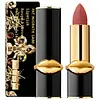What's inside
What's inside
 Key Ingredients
Key Ingredients

 Benefits
Benefits

 Concerns
Concerns

 Ingredients Side-by-side
Ingredients Side-by-side

Isoamyl Laurate
EmollientIsodecyl Neopentanoate
EmollientOctyldodecanol
EmollientDicalcium Phosphate
AbrasiveSilica
AbrasiveSynthetic Wax
AbrasiveC10-18 Triglycerides
EmollientHelianthus Annuus Seed Wax
Skin ConditioningKaolin
AbrasiveLimnanthes Alba Seed Oil
Skin ConditioningEuphorbia Cerifera Wax
Synthetic Beeswax
Emulsion StabilisingEthylhexyl Palmitate
EmollientSilica Silylate
EmollientCaprylic/Capric Triglyceride
MaskingPolyhydroxystearic Acid
EmulsifyingTetrahexyldecyl Ascorbate
AntioxidantTocopheryl Acetate
AntioxidantDisteardimonium Hectorite
StabilisingEthyl Vanillin
MaskingTribehenin
EmollientIsostearic Acid
CleansingLecithin
EmollientPentaerythrityl Tetra-Di-T-Butyl Hydroxyhydrocinnamate
AntioxidantPolyglyceryl-3 Polyricinoleate
EmulsifyingRicinus Communis Seed Oil
MaskingSorbitan Isostearate
EmulsifyingHydrolyzed Sodium Hyaluronate
Skin ConditioningSodium Hyaluronate
HumectantLactic Acid
BufferingHydrogenated Castor Oil
EmollientPalmitoyl Tripeptide-1
Skin ConditioningCI 77491
Cosmetic ColorantCI 15850
Cosmetic ColorantCI 42090
Cosmetic ColorantIsoamyl Laurate, Isodecyl Neopentanoate, Octyldodecanol, Dicalcium Phosphate, Silica, Synthetic Wax, C10-18 Triglycerides, Helianthus Annuus Seed Wax, Kaolin, Limnanthes Alba Seed Oil, Euphorbia Cerifera Wax, Synthetic Beeswax, Ethylhexyl Palmitate, Silica Silylate, Caprylic/Capric Triglyceride, Polyhydroxystearic Acid, Tetrahexyldecyl Ascorbate, Tocopheryl Acetate, Disteardimonium Hectorite, Ethyl Vanillin, Tribehenin, Isostearic Acid, Lecithin, Pentaerythrityl Tetra-Di-T-Butyl Hydroxyhydrocinnamate, Polyglyceryl-3 Polyricinoleate, Ricinus Communis Seed Oil, Sorbitan Isostearate, Hydrolyzed Sodium Hyaluronate, Sodium Hyaluronate, Lactic Acid, Hydrogenated Castor Oil, Palmitoyl Tripeptide-1, CI 77491, CI 15850, CI 42090
Isononyl Isononanoate
EmollientAluminum Starch Octenylsuccinate
AbsorbentMica
Cosmetic ColorantPolybutene
Polyethylene
AbrasiveDicalcium Phosphate
AbrasiveParaffin
PerfumingCopernicia Cerifera Wax
Squalane
EmollientHydrogenated Soybean Oil
EmollientBis-Diglyceryl Polyacyladipate-2
EmollientPentaerythrityl Tetra-Di-T-Butyl Hydroxyhydrocinnamate
AntioxidantKaolin
AbrasivePolyhydroxystearic Acid
EmulsifyingSynthetic Wax
AbrasiveStearic Acid
CleansingMicrocrystalline Wax
Emulsion StabilisingCaprylic/Capric Triglyceride
MaskingStearalkonium Hectorite
Gel FormingPropylene Carbonate
SolventNylon-12
CI 77891
Cosmetic ColorantCI 15850
Cosmetic ColorantCI 42090
Cosmetic ColorantCI 19140
Cosmetic ColorantIron Oxides
CI 45410
Cosmetic ColorantCI 15985
Cosmetic ColorantIsononyl Isononanoate, Aluminum Starch Octenylsuccinate, Mica, Polybutene, Polyethylene, Dicalcium Phosphate, Paraffin, Copernicia Cerifera Wax, Squalane, Hydrogenated Soybean Oil, Bis-Diglyceryl Polyacyladipate-2, Pentaerythrityl Tetra-Di-T-Butyl Hydroxyhydrocinnamate, Kaolin, Polyhydroxystearic Acid, Synthetic Wax, Stearic Acid, Microcrystalline Wax, Caprylic/Capric Triglyceride, Stearalkonium Hectorite, Propylene Carbonate, Nylon-12, CI 77891, CI 15850, CI 42090, CI 19140, Iron Oxides, CI 45410, CI 15985
Ingredients Explained
These ingredients are found in both products.
Ingredients higher up in an ingredient list are typically present in a larger amount.
This ingredient is an emollient, solvent, and texture enhancer. It is considered a skin-softener by helping the skin prevent moisture loss.
It helps thicken a product's formula and makes it easier to spread by dissolving clumping compounds.
Caprylic Triglyceride is made by combining glycerin with coconut oil, forming a clear liquid.
While there is an assumption Caprylic Triglyceride can clog pores due to it being derived from coconut oil, there is no research supporting this.
Learn more about Caprylic/Capric TriglycerideCi 15850 is the pigment color red. It is an azo dye and created synthetically.
Azo dyes need to be thoroughly purified before use. This allows them to be more stable and longer-lasting.
This ingredient is common in foundations, lipsticks, and blushes. This color is described as brown/orangey red.
It has many secondary names such as Red 6 and Red 7. According to a manufacturer, Red 6 usually contains aluminum.
Learn more about CI 15850Ci 42090 is a synthetic dye created from petroleum. It is used to give a bright blue color to cosmetics, medicine, and food.
Dicalcium Phosphate is an exfoliant.
Kaolin is a clay. It is used for oil control and to help minimize pores. Like other clays, kaolin has the ability to absorb excess sebum or oil. This can help clean out pores and mattify the skin.
Some types of kaolin may have exfoliating properties. When water is added to kaolin, it becomes a paste with small abrasive particles.
Most kaolin is a white color, but may be pink/orange/red depending on where it comes from.
The name 'kaolin' comes from a Chinese village named 'Gaoling'. Kaolin clay comes from rocks rich in kaolinite. Kaolinite, the mineral, has a silicate layered structure. Kaolinite is formed from chemical weathering of aluminum siilicate minerals.
Besides skincare, kaolin is commonly used to make glossy paper, in ceramics, toothpaste, and as medicine to soothe stomach issues.
Learn more about KaolinPentaerythrityl Tetra-Di-T-Butyl Hydroxyhydrocinnamate (long name, huh?) is a synthetic antioxidant.
It is used to help stabilize other antioxidants or prevent the color from changing in a product.
As an antioxidant, it helps fight free-radical molecules. Free-radical molecules are capable of damaging our cells and other genetic material. Thus, antioxidants may reduce the signs of aging.
This ingredient is oil-soluble.
Learn more about Pentaerythrityl Tetra-Di-T-Butyl HydroxyhydrocinnamatePolyhydroxystearic Acid is a soft wax made from castor oil.
It is is a texture thickener, emulsifier, and film-former. Emulsifiers prevent ingredients from separating, such as oils and waters.
Polyhydroxystearic Acid may not be fungal acne safe.
Learn more about Polyhydroxystearic AcidSynthetic Wax is created from fossil fuels such as natural gas. It is used to enhance texture, adjust pH, and as an occlusive.
It may also be used as an abrasive ingredient to exfoliate the skin.
Synthetic Wax may not be fungal acne safe.
Learn more about Synthetic Wax